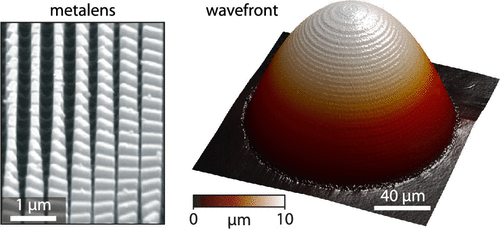当前位置:
X-MOL 学术
›
ACS Photonics
›
论文详情
Our official English website, www.x-mol.net, welcomes your
feedback! (Note: you will need to create a separate account there.)
Metasurface Optical Characterization Using Quadriwave Lateral Shearing Interferometry
ACS Photonics ( IF 6.5 ) Pub Date : 2021-01-13 , DOI: 10.1021/acsphotonics.0c01707 Samira Khadir 1, 2 , Daniel Andrén 3 , Ruggero Verre 3 , Qinghua Song 1 , Serge Monneret 2 , Patrice Genevet 1 , Mikael Käll 3 , Guillaume Baffou 2
ACS Photonics ( IF 6.5 ) Pub Date : 2021-01-13 , DOI: 10.1021/acsphotonics.0c01707 Samira Khadir 1, 2 , Daniel Andrén 3 , Ruggero Verre 3 , Qinghua Song 1 , Serge Monneret 2 , Patrice Genevet 1 , Mikael Käll 3 , Guillaume Baffou 2
Affiliation

|
An optical metasurface consists of a dense and usually nonuniform layer of scattering nanostructures behaving as a continuous and extremely thin optical component with predefined phase, transmission and reflection profiles. To date, various sorts of metasurfaces (metallic, dielectric, Huygens-like, Pancharatman-Berry, etc.) have been introduced to design ultrathin lenses, beam deflectors, holograms, or polarizing interfaces. Their actual efficiencies depend on the ability to predict their optical properties and to fabricate nonuniform assemblies of billions of nanoscale structures on macroscopic surfaces. To further help improve the design of metasurfaces, precise and versatile postcharacterization techniques need to be developed. Today, most of the techniques used to characterize metasurfaces rely on light intensity measurements. Here, we demonstrate how quadriwave lateral shearing interferometry (QLSI), a quantitative phase microscopy technique, can achieve full optical characterization of metasurfaces of any kind, as it can probe the local phase imparted by a metasurface with high sensitivity and a spatial resolution that reaches the diffraction limit. As a means to illustrate the versatility of this technique, we present measurements on two types of metasurfaces, namely, Pancharatnam-Berry and effective-refractive-index metasurfaces, and present results on uniform metasurfaces, metalenses, and deflectors.
中文翻译:

使用四波横向剪切干涉法进行超表面光学表征
光学超表面包括密集且通常不均匀的散射纳米结构层,其表现为具有预定相位,透射和反射轮廓的连续且极其薄的光学组件。迄今为止,已经引入了各种超颖表面(金属的,介电的,类似于惠更斯的,Pancharatman-Berry等)来设计超薄透镜,光束偏转器,全息图或偏振界面。它们的实际效率取决于预测其光学性质以及在宏观表面上制造数十亿个纳米级结构的不均匀组件的能力。为了进一步帮助改进超表面的设计,需要开发精确而通用的后表征技术。如今,用于表征超表面的大多数技术都依赖于光强度测量。这里,我们证明了定量相显微镜技术四波横向剪切干涉术(QLSI)如何实现任何种类的超颖表面的完整光学表征,因为它可以以高灵敏度和到达衍射的空间分辨率探测超颖表面所赋予的局部相限制。为了说明该技术的多功能性,我们介绍了两种类型的超颖表面的测量值,即Pancharatnam-Berry和有效折射率超颖表面,并给出了均匀超颖表面,金属质感和偏转器的结果。因为它可以以高灵敏度和达到衍射极限的空间分辨率探测超表面赋予的局部相。为了说明该技术的多功能性,我们介绍了两种类型的超颖表面的测量值,即Pancharatnam-Berry和有效折射率超颖表面,并给出了均匀超颖表面,金属质感和偏转器的结果。因为它可以以高灵敏度和达到衍射极限的空间分辨率探测超表面赋予的局部相。为了说明该技术的多功能性,我们介绍了两种类型的超颖表面的测量值,即Pancharatnam-Berry和有效折射率超颖表面,并给出了均匀超颖表面,金属质感和偏转器的结果。
更新日期:2021-02-17
中文翻译:

使用四波横向剪切干涉法进行超表面光学表征
光学超表面包括密集且通常不均匀的散射纳米结构层,其表现为具有预定相位,透射和反射轮廓的连续且极其薄的光学组件。迄今为止,已经引入了各种超颖表面(金属的,介电的,类似于惠更斯的,Pancharatman-Berry等)来设计超薄透镜,光束偏转器,全息图或偏振界面。它们的实际效率取决于预测其光学性质以及在宏观表面上制造数十亿个纳米级结构的不均匀组件的能力。为了进一步帮助改进超表面的设计,需要开发精确而通用的后表征技术。如今,用于表征超表面的大多数技术都依赖于光强度测量。这里,我们证明了定量相显微镜技术四波横向剪切干涉术(QLSI)如何实现任何种类的超颖表面的完整光学表征,因为它可以以高灵敏度和到达衍射的空间分辨率探测超颖表面所赋予的局部相限制。为了说明该技术的多功能性,我们介绍了两种类型的超颖表面的测量值,即Pancharatnam-Berry和有效折射率超颖表面,并给出了均匀超颖表面,金属质感和偏转器的结果。因为它可以以高灵敏度和达到衍射极限的空间分辨率探测超表面赋予的局部相。为了说明该技术的多功能性,我们介绍了两种类型的超颖表面的测量值,即Pancharatnam-Berry和有效折射率超颖表面,并给出了均匀超颖表面,金属质感和偏转器的结果。因为它可以以高灵敏度和达到衍射极限的空间分辨率探测超表面赋予的局部相。为了说明该技术的多功能性,我们介绍了两种类型的超颖表面的测量值,即Pancharatnam-Berry和有效折射率超颖表面,并给出了均匀超颖表面,金属质感和偏转器的结果。











































 京公网安备 11010802027423号
京公网安备 11010802027423号